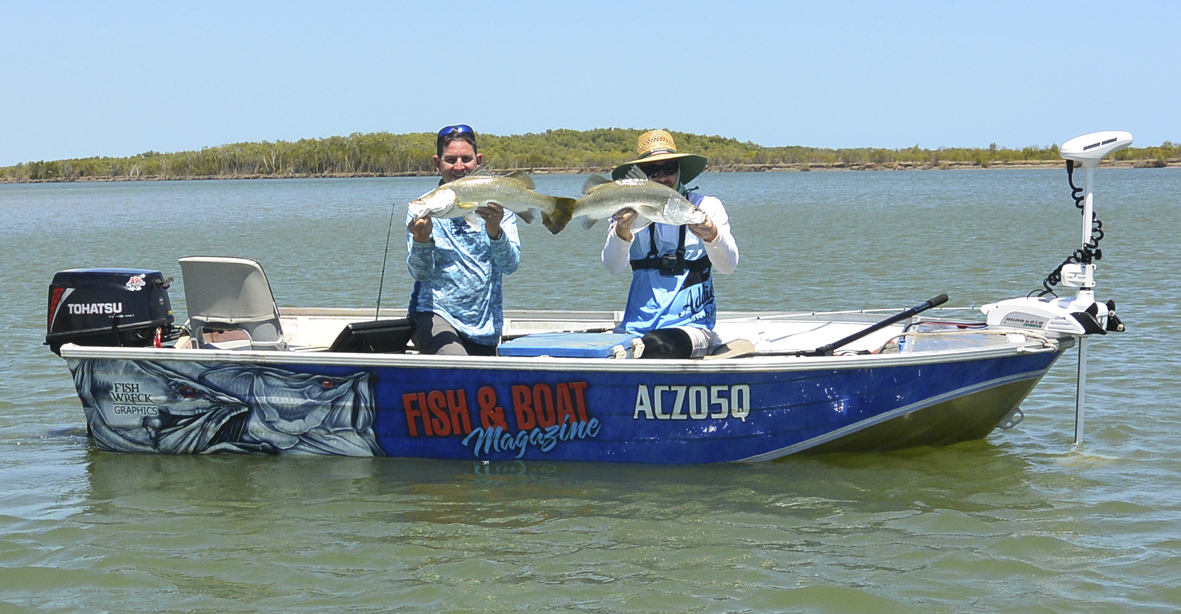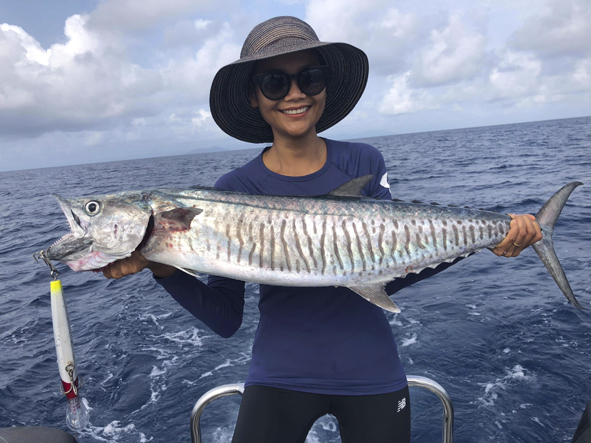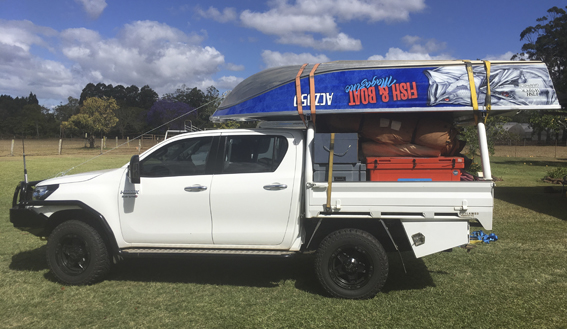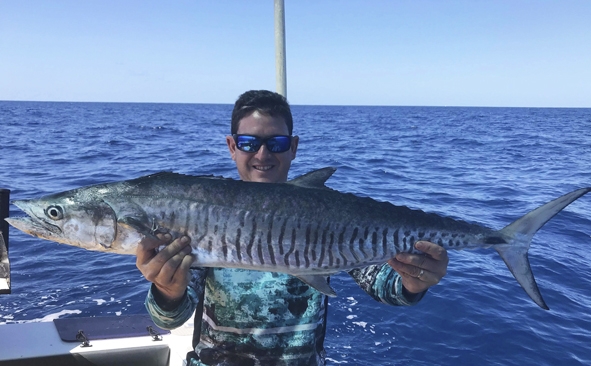Sensational Saury – By Dan Kaggelis
Tying on a big hardbody lure and sending it back in the spread always brings a sense of excitement. Like all types of fishing, trolling lures for pelagic fish like Spanish mackerel, wahoo, tuna and marlin is about setting a trap and convincing these predators of the deep blue sea to fall into it.
When setting this trap there are plenty of things to consider such as where and when is the best time for trolling and most importantly what lures to troll. Get all these things right and you will be right in the game for some hard-running drag peeling fun.
One of the first things to consider with trolling lures for pelagic fish is water colour. Most pelagic fish utilise sight to feed and therefore clean, clear, blue water will always produce better results than dirty green water.
This is particularly the case in inshore areas where after a spate of bad weather the water can become dirty and green coloured making trolling lures difficult.
One of the reasons I love trolling lures off Cairns is the relatively short distance you have to travel to find that deep blue purple offshore water which is perfect for this type of fishing.
Once you have found that right coloured water, the next part of the trap is deciding where and when to troll your lures. Pelagic fish are the same as demersal fish – they all love to hang around bait and food sources, so you need to find where these are congregating. This is where tidal flow is vital.
Bait will be funnelled and congregated by tidal currents on the edges of reefs, spurs and even deep-water pinnacles or bombies. When looking for places to troll, choose a tidal affected or pressure edge of a reef system and before running out your lures, take some time to reconnaissance the area to identify where the bait is holding, which way it is facing and at what depths it is holding.
Once you have located the bait schools, you can then set your lure spread out and target the most productive areas that have more chance of holding fish. In some areas it may be a single large bombie which is holding all the bait and it can be as simple as just trolling over the bombie time and time again for success.
On one occasion this year we located a large bombie in 40 metres of water packed with bait and we decided to troll over it to see if any macks were hanging about. Once the lures crossed over the bombie all three lines went screaming off resulting in three Spanish mackerel all around the 8kg mark. The second and third pass resulted in the exact same outcome which was epic. These types of spots are gold to have in your GPS as they are magnets for pelagics all year round.
In terms of when to troll, early mornings and late afternoons are always great but tide changes and flow should always be prioritised as this will influence the bait which will bring in the fish.
 If you are trolling the deeper water areas like on the edge or off the continental shelf for larger pelagic predators such as wahoo and dog tooth tuna, it’s a little harder to make decisions as to where to lay your spread as there are less defined structures which will hold the bait and fish. This is where you need to use your bathometric charts to identify areas where rises may be present or large pinnacles may push closer to the surface. These areas will create convergence points which will funnel and congregate bait schools and are likely places that large pelagic fish may hang out and feed.
If you are trolling the deeper water areas like on the edge or off the continental shelf for larger pelagic predators such as wahoo and dog tooth tuna, it’s a little harder to make decisions as to where to lay your spread as there are less defined structures which will hold the bait and fish. This is where you need to use your bathometric charts to identify areas where rises may be present or large pinnacles may push closer to the surface. These areas will create convergence points which will funnel and congregate bait schools and are likely places that large pelagic fish may hang out and feed.
Usually with fish such as wahoo and Spanish mackerel, if you can find one fish then you will have found a school so multiple hook-ups are very possible. Therefore, if you do hook a fish, it’s a good idea to keep the boat motoring forward for a while keeping the other lures in the spread swimming in effect leaving the trap open for another fish to fall victim.
This is a little easier to do with Spanish mackerel as they have less power and aggression than wahoo. Wahoo can strip plenty of line quickly on a single run, so it can be a double-edged sword if you employ this method. This is where you need to match your gear to the target species and making sure you have enough stopping power to at least slow them down.
Using light line is fine as most pelagics, apart from dog tooth, are not inclined to run you into the reef, however sharks love to hang in the same areas and will happily have a bite on your hooked fish.
Once you have figured out where and when to lay your trap, it’s time to decide what lures you are going to troll. When it comes to hard body lure selection there are plenty of reputable lures on the market but if you are after a hardbody lure which is right up, then the Bluewater Saury is a very good option. There are plenty of points of difference with the Saury compared to others on the market starting with size.
Most hardbody trolling lures are around that 15 to 20cm in length whilst the Saury comes in at 27cm which makes it a large obvious presentation which really stands out in the water. Not only are they big they are also loud in the water with an awesome swimming action that really creates plenty of attraction.
Depending on the speed trolled and how far out the back of the spread you run them, I have gotten them down to around 5 metres in depth which is ideal for that good all-round depth to target pelagic fish. The big standout however is the build of these lures. The saury is built like a battle tank with full stainless-steel wire through construction. The bibs of these lures are double reinforced which means they can take a front-on attack by a big fish and not crack which is a common problem with many hardbody lures. Nothing worse than turning your lure into a stick bait after a single fish.
The tow point is also awesome and is nose wired which means the lure will swim straight right out of the box. There is no need to play with bibs or mess with the nose with this lure. Unfortunately, this is becoming quite a common fault with many troll hardbodies and can really be a pain when you fork out good money and the lure doesn’t swim right.
Finally comes the terminal tackle and hooks which are top notch. Fitted standard with 9/0 VMC single hooks and heavy-duty rings and hardware, this lure can take down some pretty big fish with no worries about bending hooks or straightening rings. If you prefer to use trebles over singles, it’s a pretty easy option to swap them over however I prefer singles especially when targeting oversized fish as they have less chance of working the trebles against each other and when you hook-up on a single, you stay hooked up.
Trolling hardbodies is a great way to fish especially for hard running drag burning pelagics. So next time you see a patch of clean blue water and a pressure edge full of bait at your favourite reef, take the time to throw out a Saury or two and get hooked up proper.





